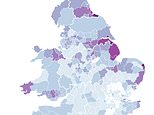
North East Lincolnshire is the teenage pregnancy capital of England and Wales, MailOnline can today reveal.
Nearly 7 per cent of all births in the council area, home to fishing port Grimsby as well as neighbouring seaside towns Cleethorpes and Immingham, were to women under 20 in 2023.
Despite being the hotspot for teen pregnancies, rates have more than halved in the authority since the early noughties.
North East Lincolnshire’s decline mirrors the nationwide slump over the past decade, with teen pregnancies at the lowest levels since records began in the 1960s.
Only one authority – Babergh – has bucked the trend.
Little more than 3.2 per cent of women giving birth in the area, stretching from the southern outskirts of Ipswich to the Essex border and deep into Suffolk, last year were under 20.
In 1993, when the Office for National Statistics (ONS) began collecting birthing data by age and authority, the rate stood at 3 per cent.
Experts say falling rates might be down to youngsters nowadays being put off getting pregnant young because they’re inspired to focus on their future career and education instead.
Teen pregnancy rates have plunged, even in deprived areas, since the launch of Tony Blair’s Teenage Pregnancy Strategy, which was designed to increase sex education and contraception.
Easier access to the morning-after pill, long-term contraception and abortions has also encouraged rates to fall, as well as youths being more responsible and drinking less than previous generations.
Alison Hadley OBE, who led the then-Government’s strategy, said: ‘Before the introduction of the previous Labour Government’s 10 year Teenage Pregnancy Strategy in 1999, our historically high teenage pregnancy rates were often viewed as an intractable part of English culture, impermeable to prevention.
‘The strategy proved that wrong.
‘Through improving relationships and sex education – at school, home and community – making effective contraception easy to access, and linking to programmes aimed at reducing alcohol and drug use, and raising young people’s aspirations, the Strategy equipped young people to make well informed choices about if and when they became pregnant, and rates came down.’
Hadley, director of the Teenage Pregnancy Knowledge Exchange at the University of Bedfordshire, added: ‘This is not the time to say rates are falling so the job is done.
‘Instead, we should refocus on equipping young people to prevent pregnancies they don’t want, and provide dedicated support for young parents to halt widening inequalities.
‘Joining teenage pregnancy work with other government youth programmes will help re-build an effective prevention eco-system for all young people. Spending on young people now is investment in the future.’
Despite plunging rates of pregnancy among young women, Britain remains one of the teenage mother capitals of Europe.
Of 23 Western European nations, the UK ranks behind just Malta, Monaco and Gibraltar in terms of fertility rates of teenage women.
For every 1,000 British women aged 15-19, there are 8.4 births, according to data held by the World Bank. France’s equivalent rate is below four while Ireland’s is close to 4.2
The decline in teenage pregnancies comes after MailOnline last month revealed how fertility rates have plunged in every local authority in England and Wales over the past decade.
Alarming figures laying bare the ‘baby bust’ revealed some boroughs saw a 60 per cent decline in women having children since 2013.
Experts fear the freefalling rates will trigger an ‘underpopulation’ crisis, potentially leaving Britain reliant on immigration to prop up our economy.
Women in England and Wales, on average, now only have 1.44 children.
This is the lowest since records began in the 30s and half of levels seen during the mid-60s baby boom.
Almost a third of all 591,000 babies born were to foreign mothers in 2023, the latest year with full data available.
This article was originally published by a www.dailymail.co.uk . Read the Original article here. .

